Learning the history of evolution and primatology
An exhibition and undergraduate course at Stanford examines the peculiar scrutiny people have placed on their primate relatives to better understand the human condition.
Go to the web site to view the video.
Ever since Charles Darwin claimed in 1871 that humans and other primates share a common ancestor, people have turned to apes in search of an answer to the age-old question: What makes us human?
A new collaboration between Stanford historians Jessica Riskin and Caroline Winterer takes up this question, and their efforts have culminated in an exhibition in Green Library’s Hohbach Hall, The Apes & Us: A Century of Representations of Our Closest Relatives, an accompanying color catalog, a conference, and most recently, a winter quarter Introductory Seminar (IntroSem), HIST 41Q: The Ape Museum: Exploring the Idea of the Ape in Global History, Science, Art and Film, where students study with original source material to learn how people have viewed and exploited apes in science and across society through the ages.
“Students can see what people around the world in the 19th century were seeing – it was like the moon landing of the 20th century to suggest that all life on Earth is not only connected, but connected over an enormous span of time in which we all changed and evolved,” said Winterer, the William Robertson Coe Professor of History and American Studies in the School of Humanities & Sciences (H&S) and the author of a forthcoming book, How the New World Became Old: The Deep Time Revolution in America. “As Darwin himself put it, there’s ‘grandeur in this view of life.’ ”
But as her collaboration with Riskin shows, that revelation has been controversial from the beginning. Throughout the 19th and 20th centuries, evolution and primatology have been entangled with race, ideology, and politics.
“When you think historically about the relationship of humans to nonhuman primates, you can connect current ideas and attitudes in science and culture with their now hidden roots in the past,” said Riskin, the Frances and Charles Field Professor of History in H&S.
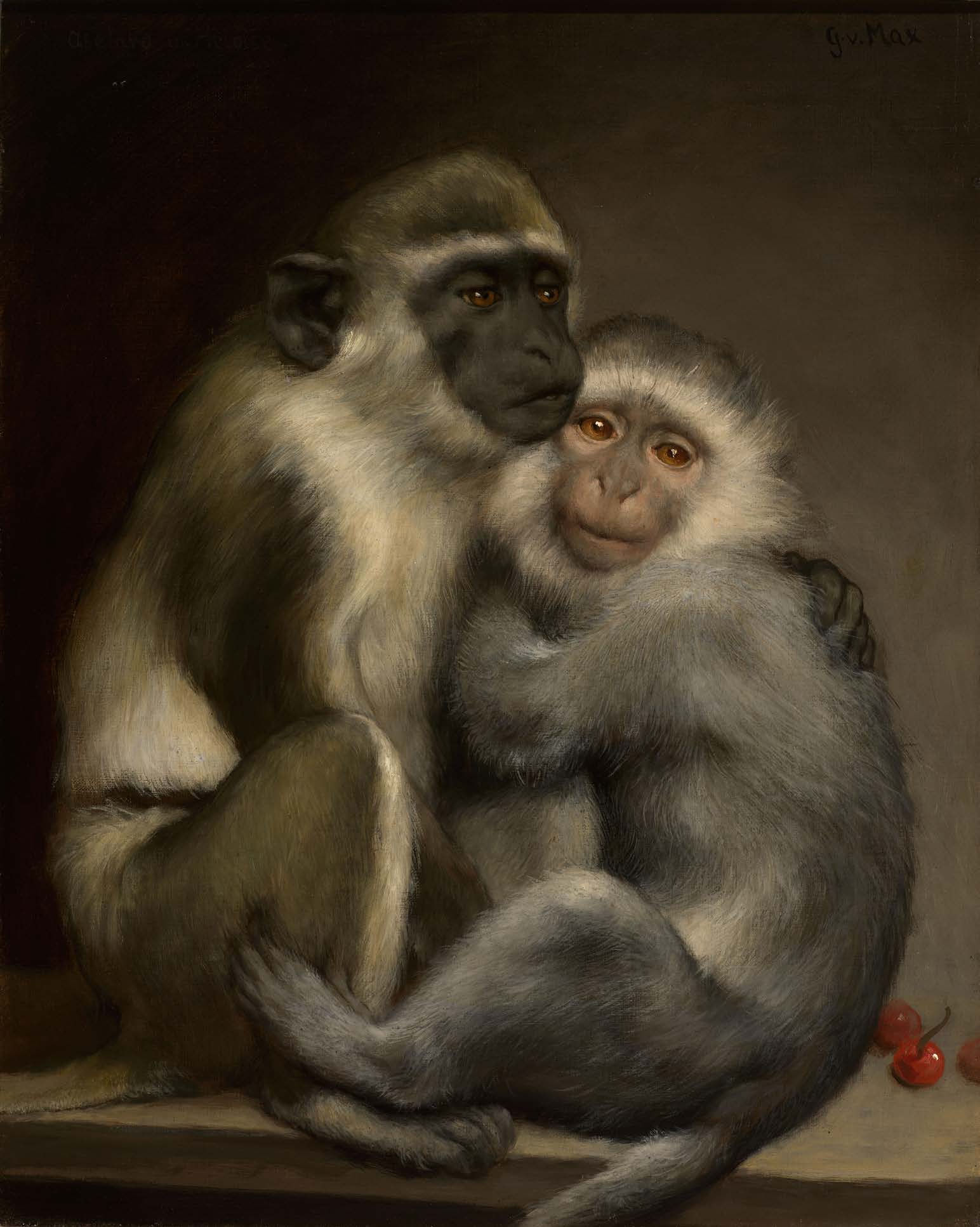
Gabriel von Max (1840-1915) Abelard und Héloïse, c. 1900-1915, oil on canvas. (Image credit: Courtesy Jack Daulton Collection)
Grappling with a paradigm shift in science
The course and exhibition on the primates and people began after Riskin visited an exhibition in 2021 at the Musée d’Orsay in Paris, The Origins of the World: The Invention of Nature in the Nineteenth Century.
Riskin described some of the items in an essay for the New York Review of Books, including the small selection of paintings by the eccentric Czech-Austrian artist Gabriel von Max (1840-1915) showing his pet monkeys assuming human-like positions and roles. Riskin described how von Max – who was an avid Darwinian as well as a painter – anthropomorphized non-human primates to emphasize Darwin’s theories that apes were closely connected to humans.
Riskin’s essay caught the attention of lawyer turned art collector Jack Daulton, who had loaned some von Max paintings to the Musée d’Orsay from his private collection. He contacted Riskin to say he lived near the Stanford campus and asked if Riskin and her students would be interested in seeing other von Max works he owns, to which Riskin enthusiastically responded, yes.
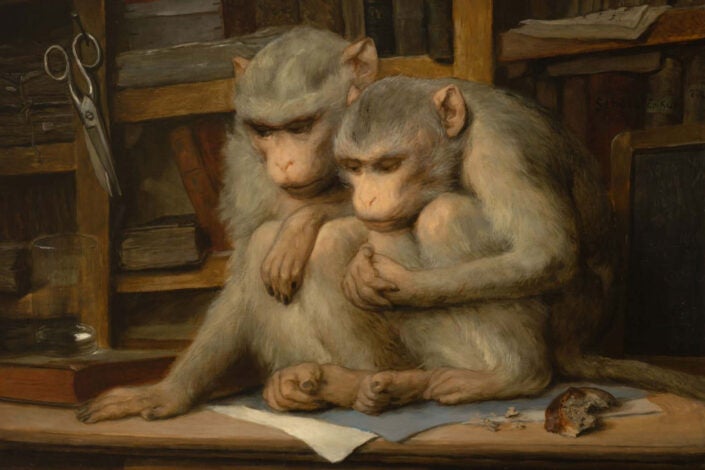
Gabriel von Max, Schlechte Zeiten / Bad Times, 1915, oil on canvas. (Image credit: Courtesy Jack Daulton Collection)
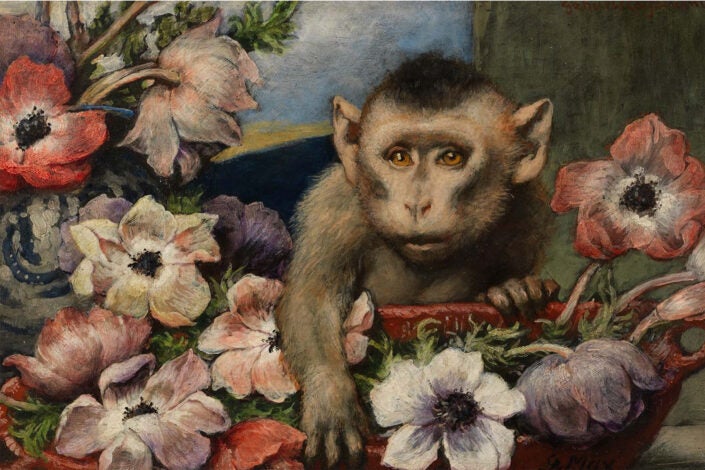
Gabriel von Max (1840-1915), Geburtstagblumen / Birthday Flowers, c. 1890, oil on wood panel. (Image credit: Courtesy Jack Daulton Collection)
Now, some 13 paintings by von Max from Daulton’s collection are on view in Hohbach Hall, including the iconic image of two capuchin monkeys holding one another tenderly, even mournfully. The painting is named after the tragic star-crossed lovers from the 12th century, Abelard and Héloïse.
In addition, there are six glass cases with items from Stanford’s own collections that show the many ways artists and scholars – at Stanford and elsewhere – have examined the differences and similarities between people and primates throughout the 19th and 20th centuries.
For example, there is a case on posture that includes an 1863 copy of Thomas Henry Huxley’s notorious diagram comparing a human skeleton to that of a gorilla, chimpanzee, orangutan, and gibbon as a way to show how our place in nature is in step with apes.
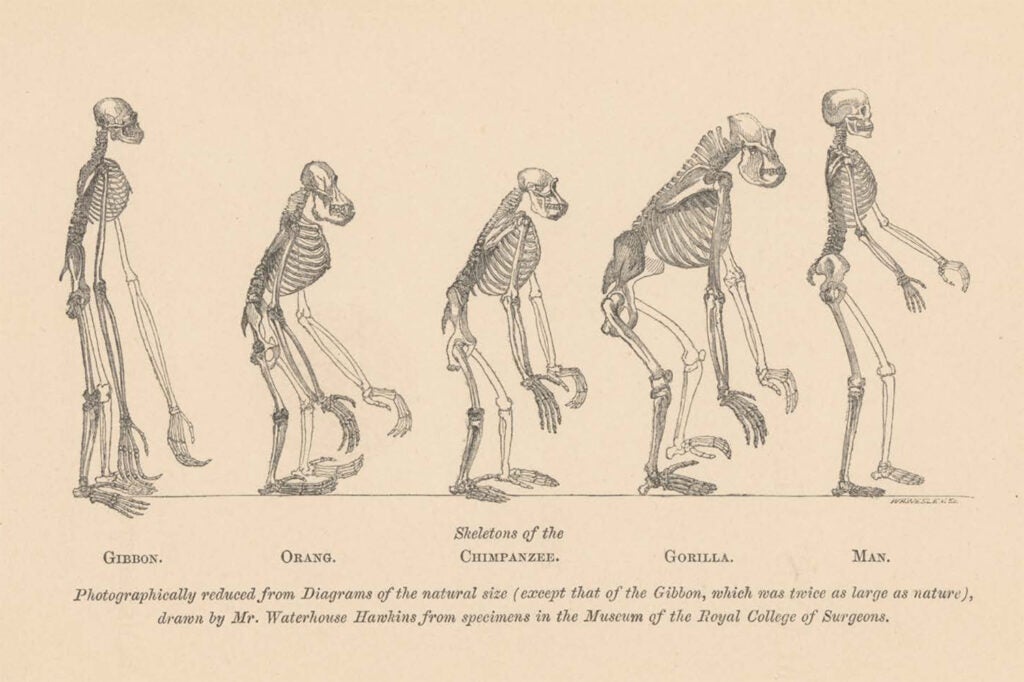
An original copy of Huxley’s diagram is on view at the Apes & Us exhibition. (Image credit: Courtesy Department of Special Collections and University Archives, Stanford University Libraries Collections)
Another case looks at tools and the hands that made them. Some have argued – such as Friederich Engels, a collaborator and close friend of Karl Marx – that the main differentiator between humans and apes is tool use. In the case is a first edition of the book from the Stanford University Archives in which Engels makes his argument.
The exhibit also shows some of the dangerous ways that differences drawn between human and non-human primates have been used to create imaginary racial and class hierarchies.
Francis Galton, Darwin’s cousin, invoked his own interpretation of Darwin’s theory of evolution to found eugenics, a field devoted to “improving” the human population through selective breeding and controlled reproduction.
One case in The Apes & Us exhibit looks at the role that the evolutionary biologist, ichthyologist, and first president of Stanford, David Starr Jordan, played in the eugenics movement in the United States.
Throughout the cases are various materials from the personal papers of Stephen J. Gould, the influential paleontologist, historian, and evolutionary biologist who spent much of his career rebutting scientific racism and biological deterministic theories. The exhibition calls attention to his 1981 book, The Mismeasure of Man, in which Gould confronts some of the pervasive tropes about race and intelligence that were prevalent throughout the Victorian era and early 20th century.
There is also a case on primate research at Stanford, including images from the Stanford Outdoor Primate Facility (SOPF) that British primatologist Jane Goodall established in 1974 with David Hamburg, Stanford professor of human biology. Their research became mired in controversy and SOPF closed in 1979.
Learning the history of science and ideas
Studying how humans have interacted with primates in a post-Darwin age is what Winterer calls a “boundary case” where different historical, political, and social perspectives can be brought to bear.
“Whenever you explore a boundary case, you’re also exploring connections,” Winterer said. “When do we erect boundaries between things? When do we create connections across boundaries? We can apply those questions to almost every domain of human thought. The ape and the human boundary or connection is really just one of many such inquiries we can make.”
Crossing in and out of these boundaries was a goal of Riskin’s and Winterer’s IntroSem.
Appropriately titled The Ape Museum, their course was held in Hohbach Hall, where each week, students interacted with items in the Apes & Us exhibit.
Students also looked at objects held elsewhere on campus, including at the Stanford University Archaeology Collections, where curator Danielle Raad presented tools and other artifacts made by human ancestors, including some estimated to be between 300,000 to 1.75 million years old.
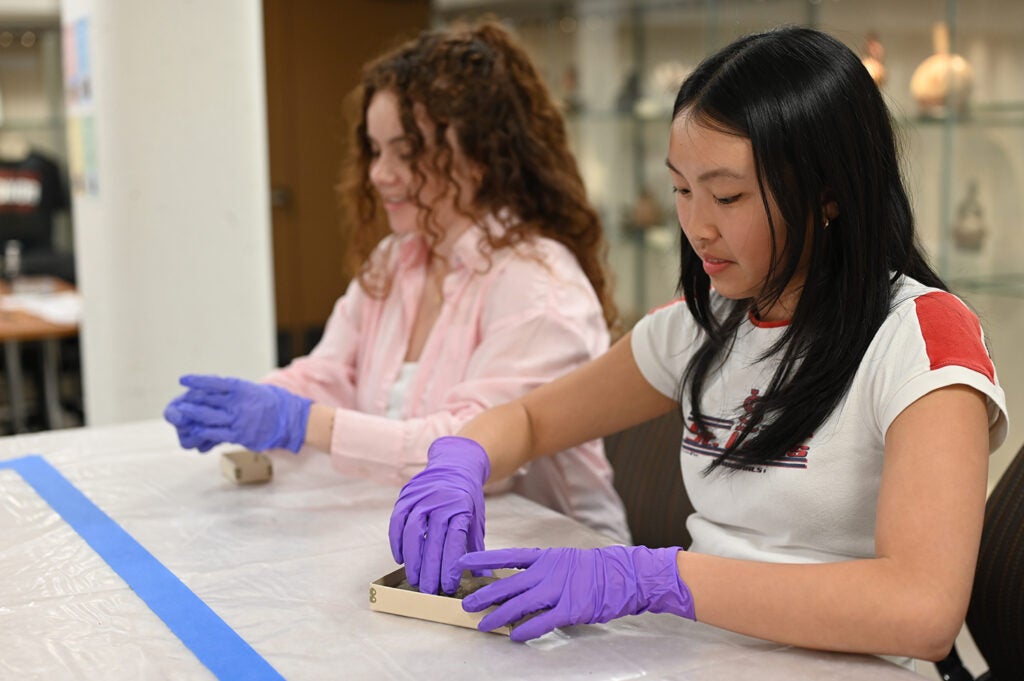
Francesca Pinney (left) and Megan Liu (right) hold ancient artifacts on a class visit to the Stanford University Archaeology Collections. (Image credit: Danielle Raad)
For freshman Francesca Pinney, holding something so distant in time and space from her was stirring. “History never felt closer,” she said.
The class also visited the Hoover Institution Library & Archives, where Jean M. Cannon, a research fellow and curator for North American Collections, pulled out propaganda from their world-renowned poster collection that showed how apes were used in World War I and II by both Allied and Axis powers to dehumanize the enemy.
Pinney said she was particularly struck by how apes were used in racist ways and the far-reaching consequences that imagery had in society.
“It was disturbing to see some of this propaganda that was so influential in dehumanizing various populations,” Pinney said. “The most haunting part of seeing those pieces of propaganda was [realizing] the prevalence of such disturbing racial components and how successful it was.”
Megan Liu, a sophomore in the course, had a similar reaction when viewing the propaganda posters – some of which were up to 4 feet wide.
“Just seeing them in their original state really showcased how effective it can be because it’s very in your face. It’s very loud. And it’s very bold,” Liu said. “It was a completely different experience seeing them at the Hoover Archive than seeing them [reprinted] on a regular piece of paper.”
The course also featured guest speakers, including course assistant Noah Sveiven, a Stanford senior who talked about his honors thesis research investigating the history of primate science at Stanford and SOPF.
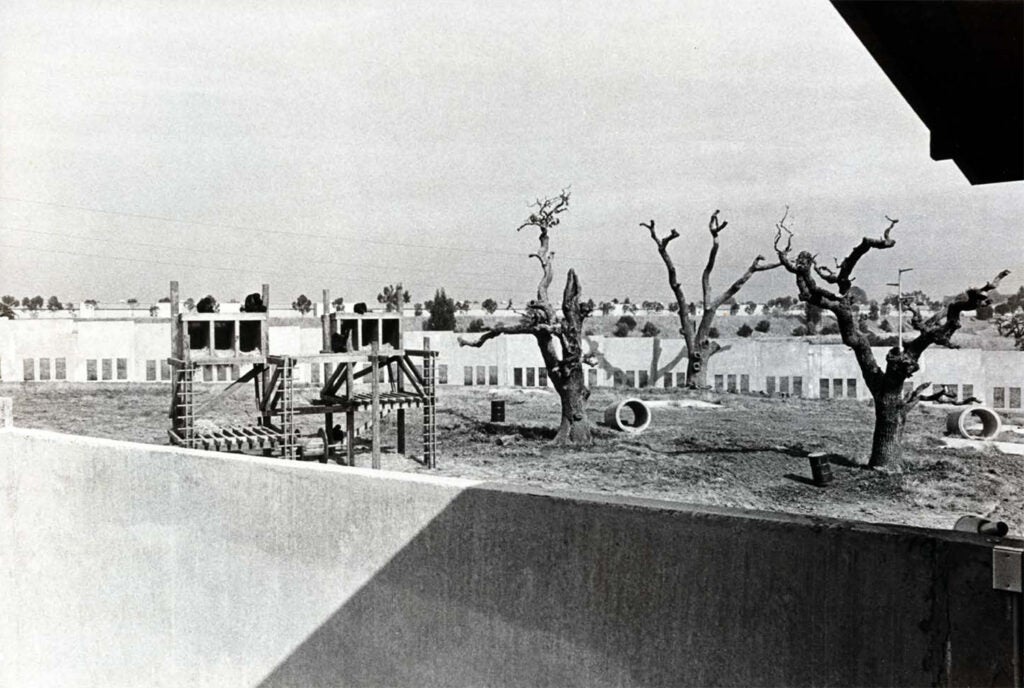
SOPF facility, c. 1974. (Image credit: Stanford University; Archives Peninsula-Times Tribune, Stanford University photographs)
The class also took an optional visit to the San Francisco Zoo, which included a poignant moment for the group with Oscar Jonesy, a 43-year-old silverback western lowland gorilla. When he saw the group entering his enclosure, he approached them and watched them – calmly and intensely – until they disappeared from view.
“It was a stare full of meaning and import somehow,” Riskin recalled of the visit. “That encounter with Oscar gave me a pang to think that he’s lived his whole life in captivity.”
Indeed, an unsettling discomfort can emerge when thinking about the treatment and ethical implications of our closest evolutionary counterparts.
It is that proximity that makes primate science controversial, said Riskin.
“All of our uncertainties, anxieties, convictions, and our whole psyche with regard to humans and humaneness comes out in primate research,” Riskin said.
Apes & Us is on view at Hohbach Hall, located on the first floor of the East Wing of the Green Library, until June 2024.
Stanford Global Studies, which is part of H&S, helped fund the course through a Course Innovation Award which supports the development of new courses focused on global topics.